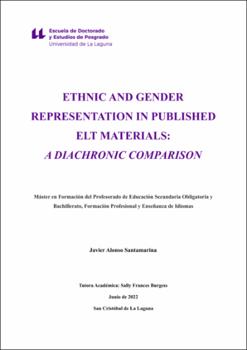Ethnic and gender representation in published elt materials: a diachronic comparison
Fecha
2022Resumen
The purpose of this research is that of comparing the representation of both gender
and ethnicity in two different examples of published English Language Teaching (henceforth,
ELT) materials; the textbook I used as a secondary education student in 2015/2016, and the
one that is currently assigned in the high school where I am doing my internship (2021/2022).
The primary objective is to see if any improvements have been made in the portrayal of these
two aspects, taking into account, above all, negative stereotyping towards women and
non-white people.
In section 2 I introduce some of the studies that have been developed in different
countries regarding racial and women’s representation in learning materials. Although there
are many such studies, it would appear that no one has looked at it specifically from a
diachronic perspective. It was this perspective I decided to take on published materials in this
study.
This dissertation could be divided into three different parts: the analyses of gender
and ethnic representation of both coursebooks under study and a proposal for counteracting
negative stereotyping.
The gender analysis begins with a categorisation of the activities to which special
attention will be paid to develop this work. Below, a review of the different units and sections
of the first book, from which several tables will be created offering quantitative data that will
later be reflected in a series of pie charts. Then, an identical procedure will be followed with
book number two. In order to achieve this task, all the images and pictures portraying human
figures have been taken into account.
Later, the same methodology will be developed in order to look at ethnic
representation, which has been separated into the pictorial depiction of white and non-white
people.
Afterwards, I introduce a proposal for counteracting negative stereotypes that a
teacher may find in the coursebook they are using, which, as we will see, is also useful for
working with the social and civic competence, a very important aspect which is included and
reflected in the guidelines established in the relevant legislation. Finally, this dissertation ends
with a section offering the results and conclusions obtained from the comparison of gender
and ethnic representation in both coursebooks, and an appendix including both the tables
carrying the quantitative data regarding both issues under study from which the graphics were
created in the analysis section as well as the materials proposed in section 5.
Key words: ethnicity, ELT materials, gender, and stereotypes. Esta investigación tiene como propósito comparar la representación tanto del género
como de la etnia en dos ejemplos de materiales didácticos para la enseñanza del inglés (de
ahora en adelante, ELT materials); el libro de texto que yo utilicé como estudiante de
Educación Secundaria Obligatoria en el curso académico 2015/2016 y el que el alumnado del
instituto en el que estoy realizando mis prácticas de máster está usando actualmente
(2021/2022). El principal objetivo sería entonces comprobar si se han llevado a cabo mejoras
en cuanto a la representación de estos aspectos, teniendo en cuenta, sobre todo, los
estereotipos negativos dirigidos hacia las mujeres y las personas no blancas.
En la sección 2, se introducen algunos de los estudios que se han realizado en
diferentes países en cuanto a la representación racial y femenina en los materiales de
aprendizaje. Aunque existen diversas investigaciones de este tipo, ninguna parece estar
enfocada específicamente desde una perspectiva diacrónica, que es la que he decidido
escoger para analizar los materiales de este estudio.
Esta disertación podría entonces ser dividida en tres partes: los análisis de la
representación de género y étnica en los dos libros de texto bajo estudio, y una propuesta para
contrarrestar los estereotipos negativos.
El análisis del género comienza con una categorización de las actividades a las que se
les ha prestado especial atención para llevar a cabo el desarrollo de este proyecto. A
continuación, se presenta una revisión de las diferentes unidades y secciones del primer libro,
a partir de las cuales se crearán una serie de tablas que ofrecen datos cuantitativos que
posteriormente serán reflejados en un conjunto de gráficos circulares. Más adelante se seguirá
el mismo procedimiento con el segundo libro. Para llevar a cabo este cometido, se han tenido
en cuenta todas las fotografías e ilustraciones que representan figuras humanas.
Seguidamente, la misma metodología será empleada para analizar la representación
étnica, que ha sido dividida en en la aparición de personas blancas y no blancas.
Luego presentaré una propuesta para contrarrestar los estereotipos negativos que el
personal docente podría encontrar en los libros de texto utilizados en el aula, que, como
veremos, será de gran utilidad para trabajar también la competencia social y cívica, un
aspecto al que la actual legislación vigente da gran importancia.
Por último, este estudio finaliza con una sección en la que se incluyen los resultados y
conclusiones obtenidos a partir de la comparación de la representación del género y la etnia
en ambos libros de texto y un apéndice que agrupa tanto las tablas cuyos datos fueron
empleados para la creación de los gráficos incluídos en la sección del análisis como los
materiales propuestos en la sección 5.
Palabras clave: estereotipos, etnia, género y materiales didácticos para la enseñanza del
inglés.





